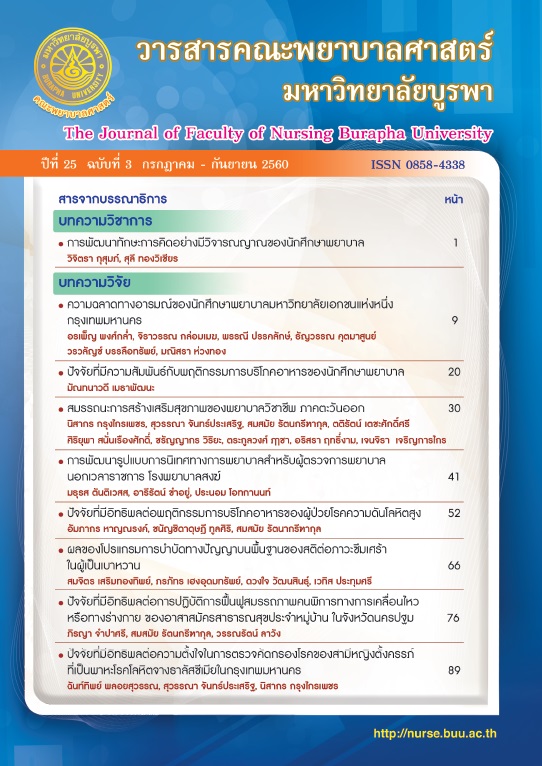การพัฒนารูปแบบการนิเทศทางการพยาบาลสำหรับผู้ตรวจการพยาบาลนอกเวลาราชการ โรงพยาบาลสงฆ์
คำสำคัญ:
รูปแบบการนิเทศทางการพยาบาล, ผู้ตรวจการนอกเวลาราชการ, nursing supervisory model, unofficial-time nursing supervisorบทคัดย่อ
การวิจัยครั้งนี้ใช้วิธีการวิจัยและพัฒนา มีวัตถุประสงค์เพื่อ พัฒนารูปแบบการนิเทศทางการพยาบาลสำหรับผู้ตรวจการพยาบาลนอกเวลา และ ประเมินรูปแบบการนิเทศทางทางการพยาบาลสำหรับผู้ตรวจการพยาบาลนอกเวลาราชการ ดำเนินการใน 3 ขั้นตอน ประกอบด้วย ขั้นตอนที่ 1 วิเคราะห์สภาพปัญหาและพัฒนารูปแบบการนิเทศทางการพยาบาล โดยวิธีการระดมสมองร่วมกับการสำรวจข้อมูลอย่างเป็นระบบด้วย ขั้นตอนที่ 2 ทดลองใช้รูปแบบการนิเทศทางการพยาบาลโดยมีคู่มือการนิเทศโดยละเอียด และขั้นตอนที่ 3 การประเมินรูปแบบการนิเทศทางการพยาบาลแบบใหม่โดยใช้แบบวัดความรู้และวัดทัศนคติของผู้ตรวจการพยาบาล สอบถามความพึงพอใจของผู้ตรวจการพยาบาลและของพยาบาลวิชาชีพปฏิบัติงานนอกเวลาราชการ
ผลการวิจัยพบว่า ค่าเฉลี่ยคะแนนความรู้และทัศนคติของผู้ตรวจการพยาบาลนอกเวลาราชการหลังการใช้รูปแบบสูงกว่าก่อนใช้อย่างมีนัยสำคัญทางสถิติที่ระดับ .05 ค่าเฉลี่ยความพึงพอใจของผู้ตรวจการพยาบาล และของพยาบาลของพยาบาลวิชาชีพปฏิบัติงานพยาบาลหลังการใช้รูปแบบ พบว่าอยู่ในระดับมากถึงมากที่สุด รูปแบบที่สร้างขึ้นมีขั้นตอนดำเนินการนิเทศ 3 ขั้นตอน คือ 1) การเตรียมการ (plan) ผู้นิเทศศึกษาความรู้เรื่องการนิเทศและวางแผนการนิเทศ 2) การดำเนินการ (organize) ผู้นิเทศ รับเวรและ ส่งเวร เยี่ยมตรวจทางการพยาบาล เยี่ยมตรวจทั่วไป เยี่ยมตรวจอุบัติการและค้นหาความเสี่ยง 3) การควบคุม (control) ผู้นิเทศรายงานการนิเทศ ติดตามและประเมินผลการนิเทศ ผลการวิจัยนี้แสดงให้เห็นว่ารูปแบบการนิเทศทางการพยาบาลสำหรับผู้ตรวจการพยาบาลนอกเวลาราชการนี้ สามารถนำไปใช้ได้อย่างมีประสิทธิภาพ และ พยาบาลวิชาชีพและผู้ตรวจการพยาบาลควรดำเนินการพัฒนาระบบสารสนเทศ และฐานข้อมูลเพื่อเพิ่มประสิทธิภาพของรูปแบบการนิเทศยิ่งขึ้น
Abstracts
The purposes of this study were to develop and evaluate the nursing supervisory model for unofficial-time nursing supervisors, monk’s hospital. There were three stages. The first stage was to analyze the study situation and develop the model by using focus grouping and systematically data survey. The second stage was to trial using the model by having a detailed guideline for supervisory. The last stage was to evaluate the model by using measure of knowledge, attitude of nurse supervisors, and satisfaction of nurse supervisors and unofficial-time professional nurses.
The results revealed that mean scores of knowledge and attitude of nurse supervisors after using the model were significantly higher than those before using the model at the level of p < .05. Mean score of nurse supervisors and unofficial-time professional nurses’ satisfaction was a level of high to highest. The model contained 3 stages; 1) Plan: Nursing supervisors studied knowledge about supervisory and develop plan to supervise, 2) Organize: Nurse supervisors shifting rounded and nursing supervised, generally visited, identified risk and incidence, and 3) Control: Nurse supervisors reported, followed up and evaluated the supervisory. These findings indicate that this nursing supervisory model for unofficial-time nursing supervisors could be effectively administered. Professional nurses and nursing supervisors should further develop an informatics technology system and data-based for more effectiveness of the supervisory model





